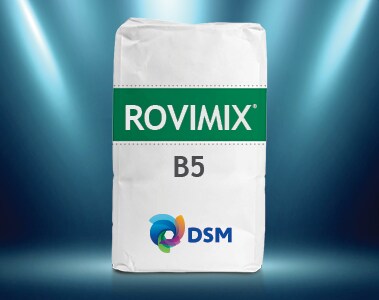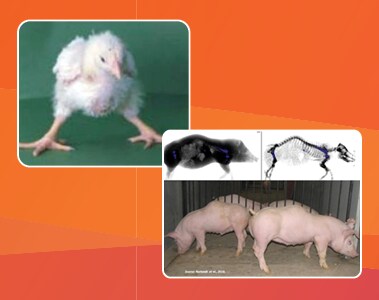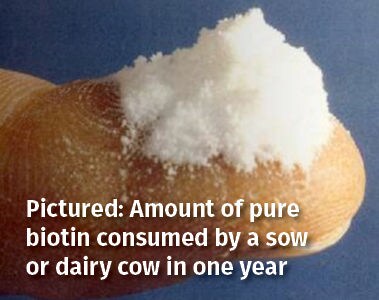Vitamins represent approximately 1% of feed costs in broiler feeds, yet take no back seat to ensure optimal growth, feed efficiency and reproductive function. Naturally occurring vitamins in ingredients vary considerably in concentration and bioavailability. Various sources of recommendations help decide vitamin supplementation levels used by commercial nutritionists. In a survey that accounted for more than 98.6% of the U.S. broiler industry, dsm-firmenich Nutritional Products ascertained the vitamin fortification rates used commercially.
Specifics of the Survey
U.S. broiler nutritionists provided vitamin premix fortification rates identified for starter, grower, finisher, and withdrawal feeds. Broiler breeder fortification levels corresponded to a lay period from 24 to 65 weeks of age.
For each vitamin, three categories were calculated.
- Hi25: High 25% of industry (average of highest 25% of values)
- AVG: Average industry (overall average)
- Lo25: Low 25% of industry (average of lowest 25% of values)
All averages are non-weighted means based on pure supplemented vitamin content. Percent coefficients of variation (CV = standard deviation divided by the mean times 100) were calculated to estimate the consistency of vitamin addition rates within feeds. The results do not included vitamins (high vitamin E, for example) supplemented separately from the premix.
Vitamin Supplementation
Broilers. In the survey, complete broiler vitamin premixes ranged between 1.06–0.68 lbs per ton (2,000 lbs) across all feeds. The vitamin premix inclusion rates declined about 36% from starter to withdrawal, as reflected in reduced fortification levels of the maturing bird (Table 1).
Vitamin supplementation averaged about 1.6–1.8 times higher in the starter period, as opposed to the withdrawal period (Table 1) when compared across starter, grower, finisher and withdrawal vitamin premixes. With no exceptions, the level of every vitamin declined from the starter period. The greatest decline existed in the vitamin fortification levels of the withdrawal phase when compared to the starter phase. Vitamin A, vitamin D, niacin, pantothenic acid, and vitamin B12 had the highest reduction in the starter to the withdrawal feed ranging from 60%–63%.
A tendency is present for vitamin levels to be decreased in the late stages of grow-out. This has been associated with performance losses, although body reserves of some vitamins exist, several factors affect the extent and reliability of tissue storage. Saving a few cents in vitamin costs can easily cost far more in lost performance.
Overall, commercial levels of several vitamins in the starter and grower periods within the Hi25 most nearly replicated Optimal Vitamin Nutrition® (OVN) recommended levels (Table 2). The OVN was developed to account for a variety of factors in commercial production that can modify vitamin requirements (i.e., lowered intestinal absorption, immunity challenges, etc.). Supplementation rates for the Lo25 were significantly lower than the Hi25 or OVN. The only vitamin that industry feeding levels fell between OVN and the average was riboflavin in the starter phase at 7.7 g/US ton.
The CV was lowest in the early feeds, but increased in the finisher and withdrawal, indicating a wider disparity in fortification rates as broilers progressed through grow-out (Table 3). Supplementation rates of riboflavin, pantothenic acid, vitamin A and niacin were less variable; while biotin, folic acid, vitamin E and K varied the most.
Breeders. Breeder fortification levels are summarized in Table 4. In breeders, vitamins serve maintenance and production purposes, and fortify eggs in preparation for embryonic development. Hence, it follows that levels are highest for this group. Broiler breeder vitamin premix inclusion rates averaged about 1.26 lbs per U.S. ton. In fact, the average breeder vitamin supplementation levels exceeded the average vitamin fortification values for the broiler starter phase.
Overall vitamin variability for breeders was similar to that for broiler starter and broiler grower fortification rates. Vitamin A was least variable (9.0%) in the broiler breeder premix, while vitamin B12 and biotin were the most variable (40% or more; Table 3). The remaining vitamins were moderate in consistency in fortification rates.
Conclusion
- Vitamin fortification levels for more than 90% of the U.S. broiler industry were tabulated
- Values show a wide disparity between the lower and higher levels of vitamins
- The highest fortification levels occurred in breeder feeds, followed by starter, grower, finisher, and withdrawal


